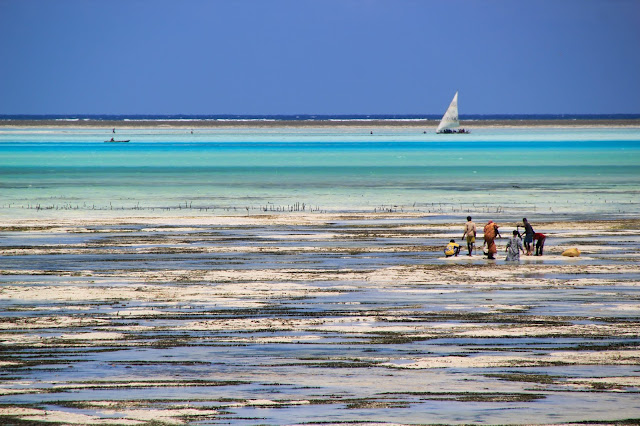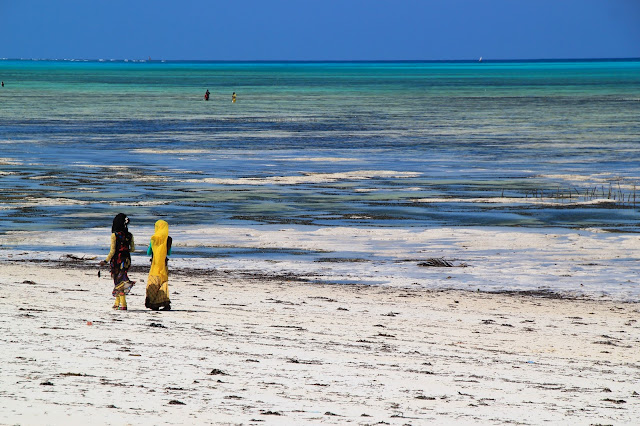Our plan for Zanzibar was to take a few days to relax after the more than 34 hours of straight travel that it took to get from Western North America to Equatorial East Africa. While planning the travel, we quickly established that the big, all-inclusive tourist resorts are mostly on the north side of the island. We didn't want anything to do with that. I don't want to waste my time in a foreign country completely shut off from the people who actually live there and their culture and food. So... our next set of options for beach breaks plus some local culture were along the east coast, and the gem that stood out above the rest there was the small village of Jambiani.
The east coast of Unguja (Zanzibar) is not as popular with tourists because of its extreme tides. When the tide is in, the water is deep and murky, and when the tide goes out, hundreds and hundreds of meters of sandy tidal plane is revealed. So, this place might not offer the crystal clear gin waters of the northern destinations, but it offers up something quite unique. I had definitely never seen a place like this before.
With the tide out, the landscape was quite surreal; it was almost like we were on some alien world. I loved it. It was intensely bright on the eyes thanks to all the exposed white sand, and the contrast between the patches of tidal pools, exposed seaweed, and brilliant blue sky was just extreme. Then there were the dhows, abandoned for the day to the extremes of the tide. There is a narrow window with which you can take them out and bring them back in again without a long hike or swim between the point where the sea is unaffected by the tide.
The people making their way across this bizarre land/sea-scape just added such a fantastic touch of character and intrigue as well. What exactly were they all doing out there?
It turns out that with these tidal flats, Jambiani is a near-ideal place for harvesting seaweed. What blew my mind was how many of the harvesters had no idea where the seaweed is being sold to. They just knew that someone local paid them to keep the plots of seaweed and harvest it whenever it was ready. Turns out that the majority of this seaweed goes to China, primarily for use in cosmetic products. Go figure, eh? I just hope (though strongly doubt) that the locals are getting their fair share of the profits on those final products to which their ingredients and hard work are so important.
The sticks poking up out of the sand provide anchors for the seaweed roots. Seeing those during the day at low tide makes one appreciate that you need to watch your step carefully when the water is in.
The locals also collect small fish and shellfish from the tidal pools to supplement their diets. I had an amazing time one night out looking for small translucent fish with some local kids. Once they found out that my friends and I had headlamps, we all the sudden became interesting and of some value to them. The group of kids broke us up into smaller groups, with each of us light-bearing mzungu (foreigners) escorted by a group of 4 or 5 kids and splitting up to optimize our effort. The little fish, the biggest of which were about the size of a thumb, were very hard to find, and even harder to catch. But with the help of the lamps, these kids were plucking them out of the water with seeming ease. They had incredible eyes and fast reflexes. It was a lot of fun helping the kids catch some tasty treats, and the kids seemed to have a great time having a laugh as they watched us try (and mostly fail) to catch the tiny and elusive prey.
When the tide is out, people are always out working the tidal pools and seaweed harvest. They stand out starkly from the softer, brighter horizon.
Again, I can't stress enough how beautiful the contrasts are in this landscapes.
Our lovely guesthouse... a series of pleasant thatch-roofed bungalows. The food was great there too.
In Jambiani, the resorts and restaurants along the beach have plenty of those beautiful carved doors too.
Tourist dollars bring plenty of opportunities and demand for workers... including Maasai from afar. There were several of these guys around Jambiani, distinctive due to their red plaid robes, facial scarring, and missing teeth. Many were selling souvenirs along the beach and several others were working security. Maasai are renowned throughout East Africa as fierce warriors and are typically armed with long knives or pointed clubs, which were used traditionally to kill lions (yes... seriously) as well as for warfare. So, they are also popular as security officers, and you see them all over the place helping to keep the peace.
There are plenty of food options along the beach in Jambiani, and we didn't have any issues with the food there. It was all really good!
Thanks to the history of foreign powers and wealth of spices and local ingredients, there is no lack of richness or taste in Zanzibari cuisine. Seafood plays a key role, but a lot of the local dishes also have their roots in Arab, Indian, and even European cuisines.
For example, there was this Biriani rice dish, which must have had $20 or more of saffron in it if it had been made anywhere in North America or Europe.
Being children with plenty of imagination but living in extreme poverty, the local kids' inventiveness for makeshift toys was just inspiring. Some of my favorites were little wind powered boats and cars made from recycled plastic bottles and plastic bags. The cars had working wheels too, and the kids raced different versions against one another, chasing them and screaming with joy as the makeshift vehicles sailed down the beach.
One of the things that appealed to me most about Jambiani as a destination, is that it is an actual village with a community of locals that are mostly not directly dependent on tourism. So, we took quite a bit of time when we were there to wander through the village and get a better feel for what life is like there.
Like I mentioned above, these people do not have a lot of money. Unfortunately, that isn't anything unusual for Africa. However, that doesn't make life any less interesting. Jambiani village was a pretty active place, with plenty of people out and about on the streets, plenty of kids going to and from school, and groups hanging out around television sets in the evenings.
The houses are simple... mostly plaster over cinder block frames and corrugated tin roofs. I didn't get to see inside at all, but it is always interesting to see how people decorate and the utilitarian and personal possessions they keep.
The main strip had a few stores, the post office, a church, and the school.
In the evenings, this market served as the local hangout and bar, serving drinks and putting a TV set outside for extra entertainment.
The kids wandering around town were adorable and definitely interested in scoping out the mzungu passing through. I'm guessing that it is only a small subset of tourists who actually take the time to walk through town.
Several of the places also had fenced areas for livestock. We saw several chickens and even some sheep around town.
Back to the beach... from here on out will mostly be pictures showing more of the beautiful area around Jambiani.
As elsewhere in the region, Islam is the predominant religion. The local women had some beautifully colored head scarves and robes, which added even more splashes of color and beauty to the landscape.
It was fun to wander through the tidal pools too scoping out the wildlife. There were tons of brittle stars.
And the views back to the shoreline were just something else too.
Then there was the lighting and how it changed from day to day and hour to hour. This place can be a playground for photographers.
Sunrise wasn't too bad either.
Simply put, Jambiani is a neat place to check out if you're interested in escaping the all-inclusive fortresses of isolation.











































1 comment:
Zanzibar Gem Plant, Description Zamioculcas is a sort of blooming plant in the family Araceae, containing the single species Zamioculcas zamiifolia. It ( Zanzibar Gem Plant) is a tropical lasting plant local to eastern Africa, from southern Kenya to northeastern South Africa.
See More: Zanzibar Gem Plant
Post a Comment